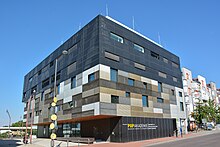Jungbusch
The Jungbusch is part of the Mannheim city district and the city center / Jungbusch district to the west of the squares that form the city center. It is bordered in the north by the Neckar , in the east and south by the Luisenring and in the west by the trading port in the Mühlau district . 5,134 people entitled to reside lived in Jungbusch on December 31, 2015. This makes it one of the most densely populated districts of Mannheim.
history
The northern Jungbusch is located on a hill that was formerly called Pestbuckel. Here the otherwise flat terrain sloping down steeply to the bank. The colloquial name is reminiscent of the cemetery once located here, where thousands of victims were buried in the plague year 1666/1667 regardless of denomination.
The name Jungbusch is derived from the young wood that used to stand here. The Jungbusch got its shape from the straightening of the Rhine , the construction of the connecting canal in the trading port and the Neckar pierced in 1869.
From 1870 onwards, the Jungbusch was created through urban expansion during the Gründerzeit. Shipowners, captains and merchants once lived here. This district was one of the few Mannheim districts that was spared the destruction of the Second World War , so that the building fabric from the early days is still very well preserved. With the decline of inland shipping in the 1970s, the Jungbusch deteriorated and turned into a red-light district with a questionable reputation (entertainment district, foreigners' district, social hotspot) in Mannheim and the surrounding area.
For some years now, the Jungbusch has been transforming into a popular trendy district for artists and creative people and as a nightlife district with bars and restaurants. Due to the increasing popularity of the district, residents fear increasing gentrification .
Residents
Today mainly low-income families live in Jungbusch. At 39.4 percent, the Jungbusch is the district in Mannheim with the lowest employment rate . This district also attracted a particularly large number of immigrants , initially Italians , then mainly Turks . 68.8 percent of the residents in Jungbusch have a migration background , Mannheim as a whole 43.6 percent. Jungbusch is also the district with the highest number of children and young people (18 percent are under 18 years of age). The inexpensive rental space in the district is increasingly being used by student shared apartments and artist studios. 12 percent of the residents receive social assistance, 23 percent of the children and young people. Despite all the social problems, the crime in Jungbusch is not noticeable.
Urban development
For several years now, the city of Mannheim has been trying to upgrade the Jungbusch with all sorts of structural and social measures . Among other things, the Popakademie Baden-Württemberg , the business start-up center Musikpark Mannheim , the creative industry center C-HUB and a gallery for temporary exhibitions ( Port25 - room for contemporary art ) were located there. Today the Jungbusch is considered a multi-cultural district with growth potential. A space for cultural and creative activities is also being created in the Kauffmannmühle, built in 1881.
History of the Kauffmannmühle
The mill system built in the years 1881–1883 by the Mannheim architects Philipp Jelmoli and Carl Blatt had its origins in a hydropower-operated grain mill in the Schriesheim Valley. When the company was relocated to Mannheim, it was named “First Mannheim Steam Mill”. Expanded and renewed at the beginning of the 20th century, the mill survived the two world wars without any significant damage. Although the mill was busy in the years after World War II, it was shut down in 1960 after 78 years of production. With the development of urban planning concepts for new workplace structures in Jungbusch, investments in the costly preservation of the old industrial monument are now also possible. The first tenants, such as the radio station for electronic music Sunshine Live or IT companies, have already moved in. Since 2007 the artist house period exit has also been located there . In a further stage, the renovation of the listed warehouses is to begin and the first section of the future guild district Kauffmannmühle with areas for high-quality products, creative services, events, slow food gastronomy and culture will be created.
religion
The Yavuz-Sultan-Selim-Mosque has stood in Jungbusch since 1995 , after completion it was the largest mosque in Germany, built by the Islamic Association of Mannheim. With its “Open Mosque” project, the mosque was one of the first Muslim places of worship in Germany that opened up to the outside world and put the goal of interreligious rapprochement and education about Islam into practice.
Opposite the mosque is the neo-Gothic Church of Our Lady , built in 1904 , which, together with the Jesuit Church and the Lower Parish Church of St. Sebastian on the market square, belongs to the Catholic inner-city parish . It is also used by the Italian community.
The Protestant harbor church also looks after the families of the inland waterwaymen who call at Mannheim harbor.
Web links
- City center / Jungbusch at www.mannheim.de
- City of Mannheim: City center / Jungbusch district brochure. (PDF 842 KB) Retrieved December 25, 2015 .
- Jungbusch Center
Individual evidence
- ↑ City of Mannheim: Population 2015 in small-scale breakdown. (PDF 679 KB) Statistical data Mannheim № 1/2016. March 30, 2016, pp. 5 ff. , Accessed on April 13, 2016 .
- ↑ City center / Jungbusch - 144 squares and 150 nations between the Rhine and Neckar
- ↑ : Is the Mannheim Jungbusch losing its soul? ( rnz.de [accessed on January 26, 2018]).
- ↑ City of Mannheim: Mannheim Social Atlas 2017. August 2018, accessed on July 31, 2019 (German).
- ^ City of Mannheim: Residents with a migration background in a small-scale breakdown, statistical data № 3/2016. (PDF 332 KB) Retrieved April 13, 2016 .
Coordinates: 49 ° 30 ' N , 8 ° 28' E




